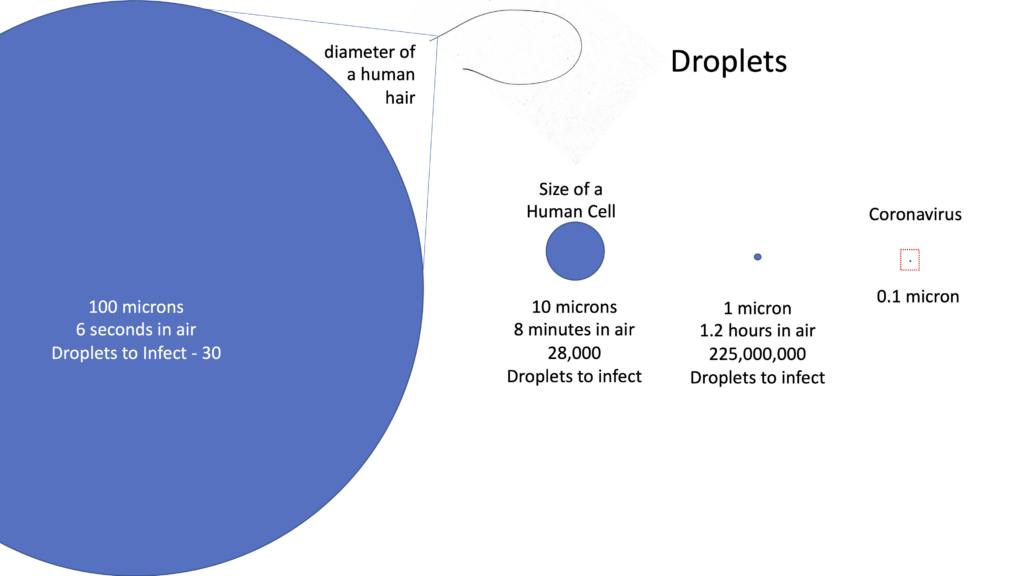Preventing COVID-19 requires that we understand ways in which it spreads. The SARS-COV-2 virus spreads in three ways:
- Direct, physical contact with an infected person.
- Airborne droplets or aerosols emitted by an infected person.
- Fomites, which are surfaces contaminated by an infected person.
Let’s take each of these in turn.
DIRECT CONTACT
A coronavirus is mind-bendingly small, 1,000 times smaller than the width of a single human hair. It can be found in the saliva, mucous, and feces of anyone with an active infection. Whether we are scratching an itchy nose or putting a finger to our lips, we are constantly touching ourselves and, if infected, contaminating ourselves, particularly our hands. Sadly, this means a hug or a handshake in the COVID era can spread a deadly disease and we should avoid doing so with anyone outside your home or your social “bubble”.
DROPLETS AND AEROSOLS
The primary way the virus is transmitted is by inhaling these microscopic droplets. In a person with COVID-19, the fluids that coat our mouths and airways are heavily contaminated with SARS-CoV-2. When people talk, sing, or even breathe, they emit tiny droplets of these fluids. If you inhale or ingest enough contaminated droplets to expose you to 1,000 or more viruses, you are likely to become infected. To understand how to protect yourself and others, it is helpful to understand something about these droplets, how they are formed, what happens to them in the air, and how we can minimize the chance that we are exposed to enough of them to become ill.
Every time you exhale, you emit a small cloud of tiny droplets, almost all of them too small to see. The size, number, and speed of these droplets increases with the force of your breath. Large droplets can contain more viruses, but they fall faster, so they do not pose a risk unless you are within a few feet. Smaller droplets travel farther, but are far less likely to contain the virus, so they only pose a risk if you are exposed to them for an extended period.
The smallest droplets (below 10 microns) are sometimes referred to as aerosols, because they fall so slowly that they act more like a gas than a drop of fluid. This distinction is somewhat artificial. It does recognize that these very small droplets linger in the air. In an enclosed space, they can accumulate, making it possible to inhale large numbers of them over an extended period. This is counterbalanced by the fact that most of them will not carry a virus. Also, they dry extremely rapidly, often in a matter of seconds, which decreases the ability of any virus that is present to survive.

The number of droplets produced and the distance they travel increases as follows:
Breathing < Talking < Singing or Talking Loudly < Coughing < Sneezing
Risk increases with the size of the droplets. Anything that increases the distance the larger droplets travel increases the need for protective measures.
We limit exposure to these droplets on set by the following measures:
- Keeping away from anyone with an active cough and coughing into our elbows if we must cough,
- Wearing masks, which both filter droplets and limit the distance traveled by those droplets that escape around the sides of the mask,
- Maintaining social distance to avoid exposure to the largest and, hence, most dangerous droplets, and
- Filtering the air and/or replacing it with fresh air.
FOMITES
A fomite is a contaminated object or surface. When droplets from people with COVID-19 accumulate on a surface, such as a table or a doorknob or when someone touches a surface with a contaminated finger or puts a cup or utensil to their lips, they deposit the virus on that surface. If someone who is uninfected puts that utensil to their mouth or touches that contaminated object with a finger that they then touch to their lips may become infected.
Fomites are not believed to be a major route of infection, but we need to be cautious.
We limit our exposure to fomites by the following measures:
- Handwashing, particularly after touching a surface shared by others.
- Avoiding touching our face when we are doing activities that involve touching shared surfaces.
- Not sharing drinks or foods with others.
- Cleaning of shared surfaces and objects between users.
